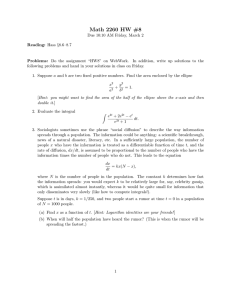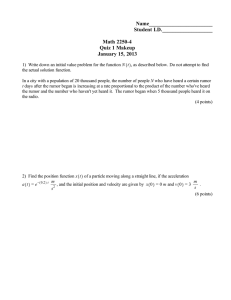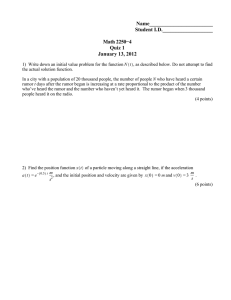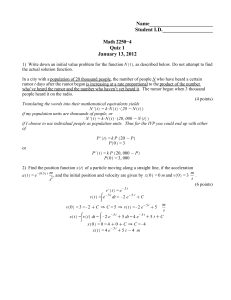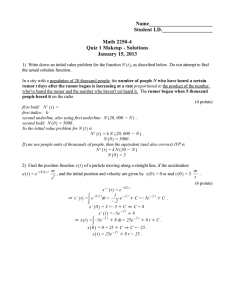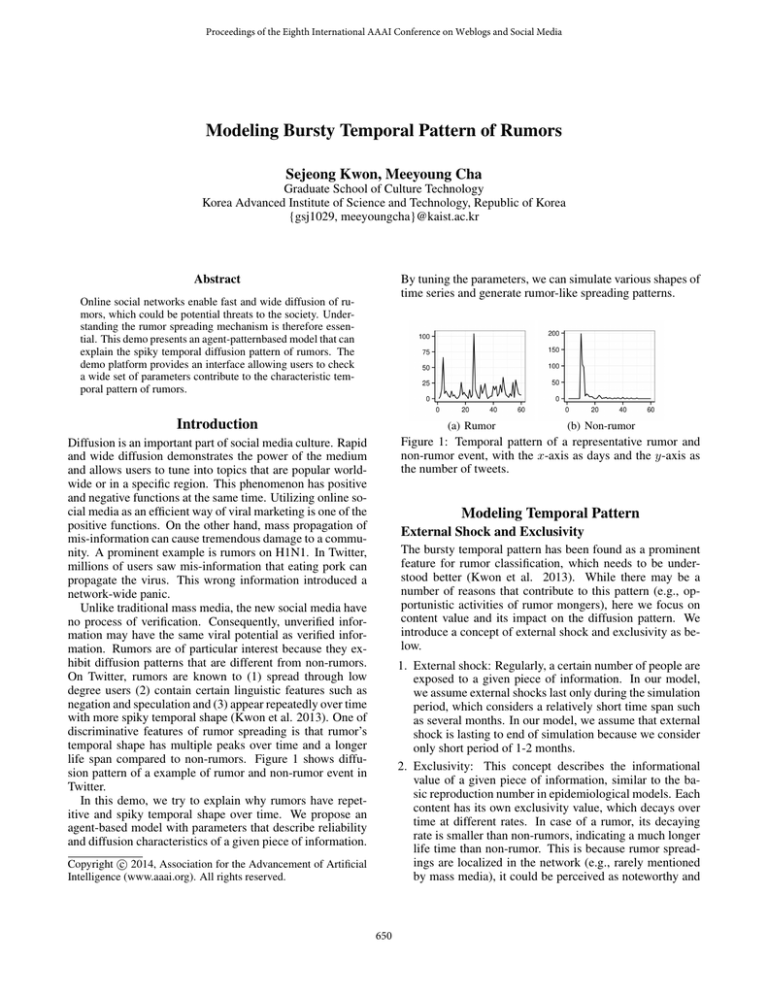
Proceedings of the Eighth International AAAI Conference on Weblogs and Social Media
Modeling Bursty Temporal Pattern of Rumors
Sejeong Kwon, Meeyoung Cha
Graduate School of Culture Technology
Korea Advanced Institute of Science and Technology, Republic of Korea
{gsj1029, meeyoungcha}@kaist.ac.kr
Abstract
By tuning the parameters, we can simulate various shapes of
time series and generate rumor-like spreading patterns.
Online social networks enable fast and wide diffusion of rumors, which could be potential threats to the society. Understanding the rumor spreading mechanism is therefore essential. This demo presents an agent-patternbased model that can
explain the spiky temporal diffusion pattern of rumors. The
demo platform provides an interface allowing users to check
a wide set of parameters contribute to the characteristic temporal pattern of rumors.
Introduction
(a) Rumor
(b) Non-rumor
Figure 1: Temporal pattern of a representative rumor and
non-rumor event, with the x-axis as days and the y-axis as
the number of tweets.
Diffusion is an important part of social media culture. Rapid
and wide diffusion demonstrates the power of the medium
and allows users to tune into topics that are popular worldwide or in a specific region. This phenomenon has positive
and negative functions at the same time. Utilizing online social media as an efficient way of viral marketing is one of the
positive functions. On the other hand, mass propagation of
mis-information can cause tremendous damage to a community. A prominent example is rumors on H1N1. In Twitter,
millions of users saw mis-information that eating pork can
propagate the virus. This wrong information introduced a
network-wide panic.
Unlike traditional mass media, the new social media have
no process of verification. Consequently, unverified information may have the same viral potential as verified information. Rumors are of particular interest because they exhibit diffusion patterns that are different from non-rumors.
On Twitter, rumors are known to (1) spread through low
degree users (2) contain certain linguistic features such as
negation and speculation and (3) appear repeatedly over time
with more spiky temporal shape (Kwon et al. 2013). One of
discriminative features of rumor spreading is that rumor’s
temporal shape has multiple peaks over time and a longer
life span compared to non-rumors. Figure 1 shows diffusion pattern of a example of rumor and non-rumor event in
Twitter.
In this demo, we try to explain why rumors have repetitive and spiky temporal shape over time. We propose an
agent-based model with parameters that describe reliability
and diffusion characteristics of a given piece of information.
Modeling Temporal Pattern
External Shock and Exclusivity
The bursty temporal pattern has been found as a prominent
feature for rumor classification, which needs to be understood better (Kwon et al. 2013). While there may be a
number of reasons that contribute to this pattern (e.g., opportunistic activities of rumor mongers), here we focus on
content value and its impact on the diffusion pattern. We
introduce a concept of external shock and exclusivity as below.
1. External shock: Regularly, a certain number of people are
exposed to a given piece of information. In our model,
we assume external shocks last only during the simulation
period, which considers a relatively short time span such
as several months. In our model, we assume that external
shock is lasting to end of simulation because we consider
only short period of 1-2 months.
2. Exclusivity: This concept describes the informational
value of a given piece of information, similar to the basic reproduction number in epidemiological models. Each
content has its own exclusivity value, which decays over
time at different rates. In case of a rumor, its decaying
rate is smaller than non-rumors, indicating a much longer
life time than non-rumor. This is because rumor spreadings are localized in the network (e.g., rarely mentioned
by mass media), it could be perceived as noteworthy and
c 2014, Association for the Advancement of Artificial
Copyright Intelligence (www.aaai.org). All rights reserved.
650
informational to some users although it spread widely in
social media.
Exclusivity is a global value defined between 0 and 1,
where 1 represents the highest level of informational value
and 0 means otherwise. Upon receiving a content, a user
will decide to propagate it further in the network if the exclusivity value of the content exceeds one’s predefined threshold. We assume users are assigned with thresholds between
0 and 1 following a uniform distribution (this can be tuned
to other probability distributions). Through external shocks,
new content gets exposed to a random set of seeds in social
media periodically(i.e., random periodic seeding in online
media).
(a) Interface (Agent-based Model via NetLogo)
Spreading Mechanism
Our model is based on an agent-based model. Followings
are the specifications about agent and parameter setting.
• N : Total population. Any integer > 0
• t: time step for agent-based model
• Exclusivity (Ie−δt )
– I: Initial value of exclusivity. it is different by types of
information and related content in the range of 0-1.
– δ: Decreasing rate. Value for rumor is smaller than
other types of information.
• External Shock (S when t = kP for k ∈ {1, 2, . . . } and
0 for otherwise)
– S: Number of users who gained a piece of information
from out of online media. Any integer > 0
– P : Any integer > 0
• Individual (Agent)
– Status: non-exposed, exposed and posted
– Threshold: Assigned from 0 to 1 with uniform distribution, randomly.
At the initial step (t = 1), we set N , I, δ, S and P . For
each agent, threshold will be assigned automatically and status is non-exposed by default.
For each time step, the model runs 4 processes. First,
agents change their spatial position randomly. Second, a
subset of agents are set as ‘exposed’ (i.e., random periodic
seeding through external shock). Third, the exposed agents
either propagates the information or ignores it based on their
thresholds. Lastly, agents who ‘post’ for the first time will
cause a subset of the nearby located agents as ‘exposed’.
These processes repeat.
(b) Tuning Parameters
(c) Simulated Time Series
Figure 2: Demo snapshot of the user interface, parameter
tuning, and a test result. The platform allows control for a
wider set of parameters, which are omitted for page limitation.
Conclusion
This demo presents an agent-based model that can explain
why the spread of misinformation has bursty temporal pattern. Based on existing social and psychological theories
about rumor spreading, we modeled several key factors that
are related to interpersonal interactions. Through this demo,
we show that the varying decaying rates of informational
value (defined as exclusivity in this work) may be a major
cause of the characteristic temporal pattern in rumor spreading. 1
References
Kosir, D. 7 tips on how to create amazing infographics,
2013.
http://tinyurl.com/q7zegml.
Kwon, S.; Cha, M.; Jung, K.; Chen, W.; and Wang, Y. 2013.
Prominent features of rumor propagation in online social
media. In proc. of IEEE International Conference on Data
Mining.
Tisue, S., and Wilensky, U. 2004. Netlogo: A simple environment for modeling complexity. In International Conference on Complex Systems, 16–21.
Demo description
The snapshots in Figure 2 shows the user interface, functionality and tuning availability of the demo platform. The platform is constructed by LetLogo (Tisue and Wilensky 2004),
a popular agent-based modeling tool. With assistance of this
tool, we can illustrate every step of the diffusion process.
The platform allows users to adjust parameters N , I, δ, S
and P , which are described in the earlier section. With this
demo, user can see examine how changes in the parameter
values such as exclusivity and the size of network cause different temporal bursty pattern of information diffusion.
1
The presenter of this demo will be first author, who developed
main hypothesis and built the simulation program.
651

